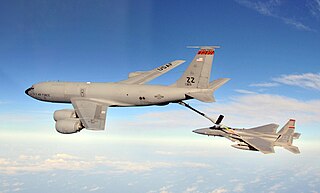
The Boeing KC-135 Stratotanker is an American military aerial refueling tanker aircraft that was developed from the Boeing 367-80 prototype, alongside the Boeing 707 airliner. It has a narrower fuselage and is shorter than the 707. Boeing gave the aircraft the internal designation of Model 717. The KC-135 was the United States Air Force (USAF)'s first jet-powered refueling tanker and replaced the KC-97 Stratofreighter. The KC-135 was initially tasked with refueling strategic bombers, but it was used extensively in the Vietnam War and later conflicts such as Operation Desert Storm to extend the range and endurance of US tactical fighters and bombers.
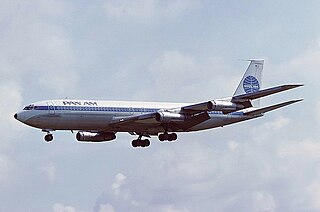
The Boeing 707 is an American long-range narrow-body airliner, the first jetliner developed and produced by Boeing Commercial Airplanes. Developed from the Boeing 367-80 prototype first flown in 1954, the initial 707-120 first flew on December 20, 1957. Pan Am began regular 707 service on October 26, 1958. With versions produced until 1979, the 707 was a swept wing quadjet with podded engines. Its larger fuselage cross-section allowed six-abreast economy seating, retained in the later 720, 727, 737, and 757 models.
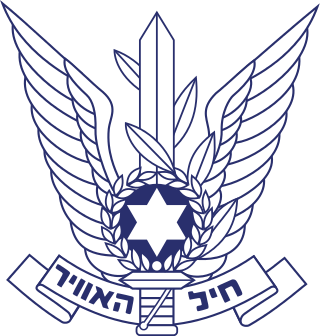
The Israeli Air Force operates as the aerial warfare branch of the Israel Defense Forces (IDF). It was founded on May 28, 1948, shortly after the Israeli Declaration of Independence. As of April 2022, Aluf Tomer Bar has been serving as the Air Force commander.

The Boeing E-6 Mercury is an airborne command post and communications relay based on the Boeing 707-300. The original E-6A manufactured by Boeing's defense division entered service with the United States Navy in July 1989, replacing the EC-130Q. This platform, now modified to the E-6B standard, conveys instructions from the National Command Authority to fleet ballistic missile submarines, a mission known as TACAMO.

Aerial refueling, also referred to as air refueling, in-flight refueling (IFR), air-to-air refueling (AAR), and tanking, is the process of transferring aviation fuel from one aircraft to another while both aircraft are in flight. The two main refueling systems are probe-and-drogue, which is simpler to adapt to existing aircraft, and the flying boom, which offers faster fuel transfer, but requires a dedicated boom operator station.
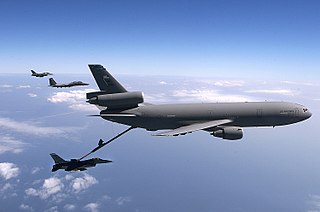
The McDonnell Douglas KC-10 Extender is an American tanker and cargo aircraft operated by the United States Air Force (USAF). A military version of the three-engine DC-10 airliner, the KC-10 was developed from the Advanced Tanker Cargo Aircraft Program. It incorporates military-specific equipment for its primary roles of aerial refueling and transport. It was developed to supplement the KC-135 Stratotanker following experiences in Southeast Asia and the Middle East. The KC-10 was the second McDonnell Douglas transport aircraft to be selected by the Air Force following the C-9. A total of 60 KC-10s were produced for the USAF. The Royal Netherlands Air Force operated two similar tankers designated KDC-10 that were converted from DC-10s.

The Boeing C-97 Stratofreighter was a long-range heavy military cargo aircraft developed from the B-29 and B-50 bombers. Design work began in 1942, the first of three prototype XC-97s flew on 9 November 1944, and the first of six service-test YC-97s flew on 11 March 1947. All nine were based on the 24ST alloy structure and Wright R-3350 engines of the B-29, but with a larger-diameter fuselage upper lobe and they had the B-29 vertical tail with the gunner's position blanked off. The first of three heavily revised YC-97A incorporating the re-engineered wing, taller vertical tail and larger Pratt & Whitney R-4360 engines of the B-50 bomber, flew on 28 January 1948 and was the basis of the subsequent sole YC-97B, all production C-97s, KC-97s and civilian Stratocruiser aircraft. Between 1944 and 1958, 888 C-97s in several versions were built, 811 being KC-97 tankers. C-97s served in the Berlin Airlift, the Korean War, and the Vietnam War. Some aircraft served as flying command posts for the Strategic Air Command, while others were modified for use in Aerospace Rescue and Recovery Squadrons (ARRS).

The Airbus A330 Multi Role Tanker Transport (MRTT) is a European aerial refuelling and military transport aircraft based on the civilian Airbus A330. A total of 16 countries have placed firm orders for approximately 68 aircraft, of which 51 had been delivered by 30 November 2020. A version of the A330 MRTT, the EADS/Northrop Grumman KC-45, was selected by the United States Air Force for its aerial tanker replacement programme, but the programme was cancelled.

The Boeing C-135 Stratolifter is a transport aircraft derived from the prototype Boeing 367-80 jet airliner in the early 1950s. It has a narrower fuselage and is shorter than the 707. Boeing gave the aircraft the internal designation of Model 717. Since the first one was built in August 1956, the C-135 and its variants have been a fixture of the United States Air Force.
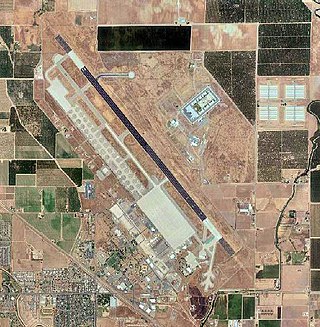
Castle Air Force Base is a former United States Air Force Strategic Air Command base in California, located northeast of Atwater, northwest of Merced, and about 115 miles (185 km) south of Sacramento.

The 305th Air Mobility Wing is a United States Air Force strategic airlift and air refueling wing under the operational control of the Air Mobility Command. It generates, mobilizes and deploys C-17 Globemaster III and KC-46A Pegasus aircraft. The 305th AMW is a tenant unit at mostly the McGuire AFB component of Joint Base McGuire-Dix-Lakehurst in central New Jersey. It also controls one of the Air Force's busiest aerial ports, and the air operations at both McGuire Air Force Base and Naval Support Activity Lakehurst.
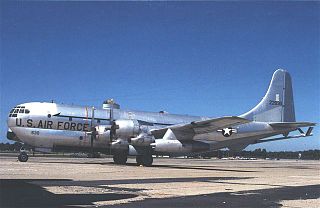
The Boeing KC-97 Stratofreighter is a four-engined, piston-powered United States strategic tanker aircraft based on the Boeing C-97 Stratofreighter. It replaced the KB-29 and was succeeded by the Boeing KC-135 Stratotanker.
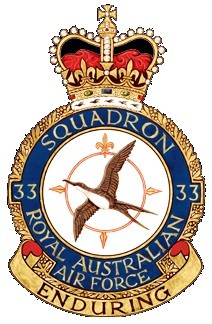
No. 33 Squadron is a Royal Australian Air Force (RAAF) strategic transport and air-to-air refuelling squadron. It operates Airbus KC-30A Multi Role Tanker Transports from RAAF Base Amberley, Queensland. The squadron was formed in February 1942 for service during World War II, operating Short Empire flying boats and a variety of smaller aircraft. By 1944 it had completely re-equipped with Douglas C-47 Dakota transports, which it flew in New Guinea prior to disbanding in May 1946.

The Boeing CC-137 was a transport and tanker aircraft which served with the Canadian Forces from 1970 to 1997. The Boeing 707-347C aircraft provided long range passenger transport for the military, VIP transport for government and air-to-air refueling for fighters such as the CF-116 Freedom Fighter and CF-18 Hornet. It was replaced by the Airbus CC-150 Polaris in the transport role and much later in the tanker role.
Nevatim Airbase, also Air Force Base 28, is an Israeli Air Force (IAF) base, located southeast of Beersheba, near moshav Nevatim in the Negev desert. It is one of the largest in Israel and has three runways of different lengths. Stealth fighter jets, transport aircraft, tanker aircraft and machines for electronic reconnaissance/surveillance, as well as the so-called Israeli Air Force One, are stationed there.

The Boeing EC-135 is a retired family of command and control aircraft derived from the Boeing C-135 Stratolifter. During the Cold War, the EC-135 was best known for being modified to perform the Looking Glass mission where one EC-135 was always airborne 24 hours a day to serve as flying command post for the Strategic Air Command in the event of nuclear war. Various other EC-135 aircraft sat on airborne and ground alert throughout the Cold War, with the last EC-135C being retired in 1998. The EC-135N variant served as the tracking aircraft for the Apollo program.

The 171st Air Refueling Wing is a unit of the Pennsylvania Air National Guard, located at Pittsburgh International Airport in Coraopolis, Pennsylvania. If activated to federal service, the Wing is gained by the United States Air Force Air Mobility Command.

The 99th Air Refueling Squadron is part of the 6th Air Mobility Wing at MacDill Air Force Base, Florida, but is stationed at Birmingham Air National Guard Base, Alabama. It is an Active Associate Unit, an active duty component attached to the Alabama Air National Guard's 117th Air Refueling Wing. The 99th Air Refueling Squadron works with, supports and flies the 117th Air Refueling Wing's Boeing KC-135R Stratotanker aircraft.

The Boeing C-137 Stratoliner is a retired VIP transport aircraft derived from the Boeing 707 jet airliner used by the United States Air Force. Other nations also bought both new and used 707s for military service, primarily as VIP or tanker transports. In addition, the 707 served as the basis for several specialized versions, such as the E-3 Sentry AWACS aircraft. The designation C-18 covers several later variants based on the 707-320B/C series. The C-137 should not be confused with the similar Boeing C-135 Stratolifter; although they share a common ancestor the two aircraft have different fuselages, among other structural differences.
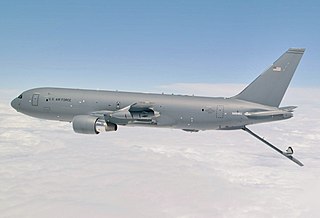
The Boeing KC-46 Pegasus is an American military aerial refueling and strategic military transport aircraft developed by Boeing from its 767 jet airliner. In February 2011, the tanker was selected by the United States Air Force (USAF) as the winner in the KC-X tanker competition to replace older Boeing KC-135 Stratotankers. The first aircraft was delivered to the Air Force in January 2019. The Air Force intends to procure 179 Pegasus aircraft by 2027.



















